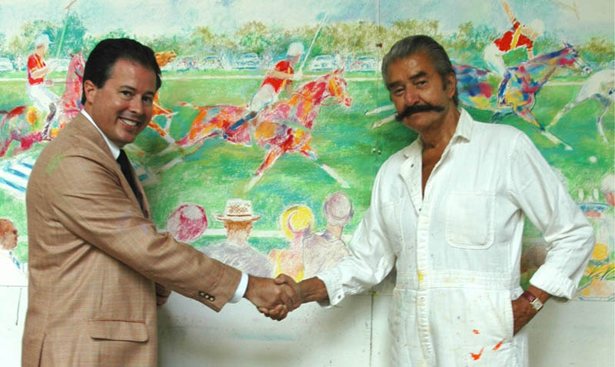
Leroy Neiman (right) with wrestling promoter David McLane, courtesy Wikimedia
I probably first learned of LeRoy Neiman when I was a teenager, through my avid reading of Playboy, or at least perusal of its pictures (LeRoy was Playboy’s staff artist). That would have been in the mid-’70s. It was around that same time that Burger King offered a free Neiman print with the purchase of a Whopper, which I thought was a splendid populist gesture for a successful artist to make. Twenty years later, the people repaid the favor: a poll commissioned by The Nation Institute and the Russian émigré artists Komar and Melamid on American tastes in art (March 14, 1994) found that LeRoy Neiman was the most famous artist in the world, living or dead.
He was reviled by the establishment art world. An “illustrator with pretensions,” somebody once sniffed. But LeRoy was without pretension, and his deft, garish action portraits of sports figures expressed something essential about the 1960s and 1970s in particular, a late American spirit also captured in Muhammad Ali’s rhymes and Tony Manero’s swagger to the opening beats of Saturday Night Fever.
I met him in 1998. The Nation was doing a special sports issue, the first in its history, and the notion of LeRoy Neiman illustrating the issue seemed like a natural. A few years earlier I had put together a show of art from the magazine’s archives, and I remembered from my research that LeRoy had contributed a drawing to the magazine in 1960. So the idea of getting Neiman to illustrate the sports issue seemed not impossible. I got the number for his studio, and soon had an appointment for myself and JoAnn Wypijewski, who was editing the issue, to meet the master.
We met in LeRoy’s grand apartment/studio in the Hotel des Artistes, a fashionable building off Central Park West. He was the first Nation artist I ever met (and the last) who had a personal assistant, not to mention several maids. Neiman owned more than a dozen apartments in the building, over twenty rooms in all, and he told us he had been forbidden to buy any more, since the co-op board feared that if he did, he could control the building.
His studio was vast, high-ceilinged, filled with the swirling garish colors of his work. Amid the many paintings propped against the walls, one stood out. It was a dark, brilliantly executed canvas that evoked Picasso’s blue period, even Goya. Neiman explained that this was an example of his early work. “It’s really good!” I said, with perhaps too much surprise. He used to paint like that, LeRoy said, but nothing ever sold, and once he discovered house paint, developed his signature style and began to paint sports figures, his career took off.
We explained our purpose and the custom of having a single artist illustrate the entire issue. I think we also mentioned that he would receive our standard $150 if he accepted the assignment. He quickly agreed—he seemed honored somehow—and invited us to lunch.
So much of that lunch is in haze now. The day was fine. We went to an outdoor restaurant on Broadway that LeRoy insisted had the best bruschetta in New York. The sun bounced off his white suit, the waiters keened to fill our glasses, the bruschetta arrived and so did Richard Belzer, who spotted LeRoy from the street and came over to say hello. He was about to have another TV show, he announced, called Law and Order. We spoke of sports and politics. LeRoy mentioned he had recently been in Cuba to watch baseball. He offered me a Cuban cigar. I declined. JoAnn had something to say about Cuba and the use of cowhide in making baseballs. The waiters brought more food and refreshed our glasses.
Walking back to his studio, he told us that he was endowing a major art program at Columbia University, thus dashing my hopes of his buying the magazine, and becoming both my boss and frequent lunch companion.
The drawings LeRoy did for the issue arrived at the office right on time, and they were great. The simple one of a batter swinging at a pitch conveyed the improbable beauty of a hit in a few bright lines. It became the cover. He also included a transparency of an old work, a dark, painterly picture of a boxer absolutely pummeled, finished it seems, but maybe about to get back in the ring. He would be happy if we wanted to use it, he said, and we did. Afterward, he called to say he was very pleased with the issue. There had been some talk of future collaboration, but time moved on and we never spoke again.
He died on June 20, at 91, an artist and a gentleman.


